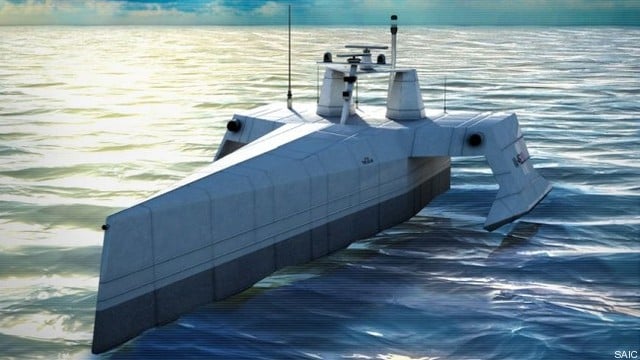Raytheon Sonar, SAIC Drone Ship Could Transform Anti-Sub Warfare
Posted on

Anti-submarine warfare has given rise to some of the best war movies — “Run Silent, Run Deep;” “The Hunt For Red October” and “Das Boot” come to mind.
The romance of the terror of being hunted and of the human conflict inherent in submarine warfare offers great material for auteurs. But the sometimes unbearable tension of a boat maneuvering through different temperature bands of water (thermoclines), hiding in plain sight and using high-tech spoofing and quirky sonar experts to survive in an underwater battle with other subs or destroyers lurking above may become a thing of the past if a new program run by the Pentagon’s Defense Advanced Research Projects Agency (DARPA) succeeds.
Its name offers absolutely no romance: the Anti-Submarine Warfare Continuous Trail Unmanned Vessel (ACTUV). Those quirky sonar operators, who dazzled their captains with their ability to tell the difference between the cavitation of a Soviet submarine and of a distant Blue Whale’s lonely call, are somewhat a thing of the past thanks to algorithms and modern computing power but this program takes that all a step further.
“Historically, manned sonars were central to anti-submarine warfare missions. However, the growing number of submarines traversing the world’s oceans makes this model unsustainable,” said Joe Biondi, vice president of Advanced Technology for Raytheon’s Integrated Defense Systems business, whose company won a contract from defense and intelligence giant SAIC to supply its Modular Scalable Sonar System for the new sub hunter.
The Raytheon sonar would search, detect, filter threats and track potential enemy subs.
The primary target of the ACTUV will not be Russian or Chinese nuclear-powered subs. Instead, it will be hunting the vast worldwide fleet of some 400 quiet diesel subs. Although nuclear subs can move with far greater speed and possess much greater range than diesels do, they aren’t necessarily as quiet as diesels are.
SAIC was awarded the $58 million contract last year by DARPA to design the surface ship to carry the Raytheon sensors and is now in the second phase of the program. DARPA describes the ship as an “unmanned vessel that tracks quiet diesel electric submarines for months at a time spanning thousands of kilometers of ocean with minimal human input.” The target cost for this is a spectacularly cheap $20 million for each ship, even though they are supposed to be able to operate for 80 days over a range of 6,200 kilometers on a single fuel load and without any people maintaining them.
One of the most interesting aspects of this approach is one that has dogged airborne unmanned aircraft — how to control them from long distances and avoid hitting other aircraft. The ACTUV would presumably be operated both from shore and from ships at sea and it would need to be able to find and track a sub without running into other surface ships. That’s a tall order.
Subscribe to our newsletter
Promotions, new products and sales. Directly to your inbox.
